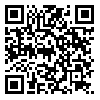BibTeX | RIS | EndNote | Medlars | ProCite | Reference Manager | RefWorks
Send citation to:
URL: http://jdisabilstud.org/article-1-3359-en.html
2- Assistant Professor in Psychology and Education of Exceptional Children, Faculty of Literature and Humanities, Science and Research Branch, Islamic Azad University, Tehran, Iran
Abstract
Background & Objectives: Autism spectrum disorder is a type of neurodevelopmental disorder. Joint attention, which is impaired in people with autism spectrum disorder, refers to the ability to jointly pay attention to something (people, objects, a concept, an event, etc.) with one or more people, and this includes the ability to acquire, maintain, and shift attention. One of the methods used in the treatment of various disorders of children with autism spectrum disorder is paying attention to the vestibular system. Also, in a new and technology–based method, researchers have invented a new therapeutic procedure to treat the problems of autistic children, which is the use of smart tools based on information and communication technology, such as a Smart interactive wall. The present study investigated the effectiveness of treatment based on improving vestibular processing with the help of a Smart interactive wall tool on improving behavior and social communication in children with autism spectrum disorder.
Methods: The current research method is a single–case quasi–experimental; out of their designs, we chose the before, after, and follow–up quasi–experimental design (multiple baseline design). The statistical population of the research consisted of all children with autism spectrum disorder referred to special autism centers in Birjand City, Iran. Therefore, using a targeted sampling method from children with autism spectrum disorder referring to one of the special centers for autism in Birjand, children with severe functional limitations based on the International Classification of Disability and Health Function (ICF) in the Welfare Disability Determination Commission Birjand were selected. Their medical records were investigated at Birjand City Welfare Center to determine the severity of children's functional limitations. After obtaining written and informed consent from their parents and based on the inclusion criteria, 6 children were selected to participate in the research. They were intervened by two methods of treatment: based on vestibular processing (3 people) and treatment with the help of a Smart interactive wall tool (3 people). The study tools were the Questionnaire of Behavioral Disorders in Autistic Spectrum Children (Parent Form) (Bardideh et al., 2010) and the Early Social Communication Scale (ESCS) (Mundy, 2003). In the treatment process, participating children were measured regarding shared attention in the baseline and four stages. Finally, two weeks after the end of the interventions and to follow up on the results again, all the subjects' parents filled out the research questionnaires. The stable change index, effect size index, and improvement percentage index were used to analyze the data.
Results: In the data analysis, the value of the reliable change index indicates that the change in the shared attention variable score of children with autism spectrum disorder from the baseline to the intervention stage is statistically significant. In addition, the effect size (3.16) indicates therapy's influential role in improving vestibular processing in joint attention of children with autism spectrum disorder. Considering the subjects' overall recovery percentage, this recovery rate is clinically significant in the intervention stage. Also, the value of the reliable change index indicates that the change in the joint attention variable score of children with autism spectrum disorder from the baseline to the intervention stage is statistically significant. In addition, the effect size (3.43) indicates the effective role of the treatment method with the help of the smart interactive wall tool in the shared attention of children with autism spectrum disorder. Considering the subjects' recovery percentage and overall recovery percentage, this recovery rate is clinically significant in the intervention stage. Also, by comparing the overall recovery percentage index and the overall effect size of subjects in two treatment methods, the results show the effectiveness of two treatment methods based on improving vestibular processing and treatment with the help of a Smart interactive wall tool in the shared attention of children with autism spectrum disorder. It's the same.
Conclusion: The results showed that the effectiveness of two treatment methods based on improving vestibular processing and treatment with the help of a Smart interactive wall tool in the shared attention of children with autism spectrum disorder is the same.
| Rights and permissions | |
 |
This work is licensed under a Creative Commons Attribution-NonCommercial 4.0 International License. |



